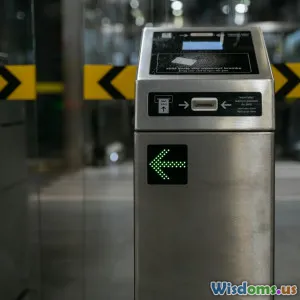
What It Takes to Build a Flood Resistant Subway System
10 min read Uncover the engineering and design strategies behind flood-resistant subway systems, safeguarding urban transit from water disasters. (0 Reviews)
What It Takes to Build a Flood Resistant Subway System
Flooding is among the most disruptive natural disasters challenging modern cities, especially those relying heavily on underground transit infrastructure. Subways buried beneath street levels can quickly become perilous traps for commuters and bottlenecks for mobility when inundated with water. With climate change amplifying the frequency and intensity of storms, developing flood-resistant subway systems has transcended from an engineering aspiration to an urgent necessity.
In this article, we dive deep into what goes into building subway systems capable of withstanding floods—unpacking engineering principles, material technologies, urban planning, and policy frameworks that together form an effective flood resilience toolkit.
The Challenge: Why Floods Are Dreaded by Subway Systems
Subways serve millions around the globe daily but are uniquely vulnerable due to their below-ground existence. Floodwaters can emanate from various sources — storm surges, flash floods, groundwater seepage, or extreme rainfall overwhelming surface drainage.
Unlike surface transit, water entering subway tunnels can rapidly submerge platforms, disable electrical systems, and halt ventilation, resulting in dangerous, multi-day shutdowns and hefty repair costs. For example, the New York City subway suffered unprecedented flooding and damage during Hurricane Sandy in 2012, with floodwaters inundating dozens of stations and tunnels, causing losses exceeding $5 billion and service disruptions lasting weeks.
Understanding the nature of these risks is crucial before exploring solutions:
- Rapid water ingress: Even small breaches allow flooding to spread swiftly.
- Electrical hazards: Water affects track power rails, signaling, and control systems.
- Structural threats: Hydrostatic pressure and corrosion weaken tunnel linings.
- Operational interruptions: Flooded platforms and flooded entrances delay evacuations.
The compelling need for infrastructure that remains safe and operational during floods demands multifaceted approaches.
Engineering Solutions: Building the Infrastructure
1. Robust Barriers and Flood Gates
Physical barriers stand as the first line of defense. Waterproof flood gates at station entrances, ventilation shafts, and tunnel portals can shut out rising waters in an emergency. For instance, London's Thames Tideway Tunnel project incorporates massive movable barriers to protect against tidal surges.
Barriers come in different forms:
- Permanent walls: Reinforced concrete walls surrounding vulnerable portals.
- Deployable gates: Can be quickly raised when forecasts predict flooding.
- Inflatable bladders: Temporary seals deployed rapidly at critical points.
The design challenge lies in ensuring barriers withstand water pressure, fit into urban spaces, and integrate with station aesthetics to avoid impeding daily pedestrian traffic.
2. Advanced Waterproofing and Sealing
Tunnel linings applied with impermeable membranes and adhesives reduce groundwater infiltration. Modern materials such as sprayed polyurethane foam layers provide durable barriers preventing seepage over decades. Leak detection systems embedded in linings alert maintenance teams before small cracks turn into major flooding pathways.
New technologies like crystalline waterproofing compounds impregnate concrete, sealing microscopic pores and self-healing small cracks via hydration mechanisms—extending the life of subway underground structures significantly.
3. Pumping and Drainage Systems
Even with barriers, some water leakage is often inevitable. Robust pumping stations continuously remove accumulated seepage or surface water entering stations.
Take Tokyo's subway, which employs redundant high-capacity pumps able to discharge thousands of liters per minute, powered by backup generators that ensure operation even during grid failures. Combined with floodwater diversion tunnels, such systems minimize flood impact.
Meticulous engineering of drainage slopes and channel networks inside tunnels further directs fluids towards sump pits, preventing water pooling on tracks.
4. Elevated Critical Electrical Components
Flood resistant design principles relocate electrical equipment, signaling gear, and transformers to elevated platforms well above anticipated flood levels. Encasing sensitive hardware in waterproof enclosures also mitigates short circuit risks.
After Hurricane Sandy, New York’s Metropolitan Transportation Authority (MTA) raised vital equipment boxes above floodplain elevations and implemented watertight cable connectors, dramatically improving resilience.
5. Structural Reinforcement and Corrosion Resistance
Subway systems utilize corrosion-resistant steel and concrete additives protecting infrastructure from saltwater damage and microbial decay common in floodwaters.
Innovations like cathodic protection systems apply protective electrical currents to tunnel linings, halting corrosion processes. Engineers also reinforce tunnel linings to withstand hydrostatic pressure changes during flooding, avoiding structural collapses.
Predictive Technology and Early Warning Systems
Advanced forecasting tools enable operators to anticipate floods and activate pre-emptive protocols. Integrating meteorological data, river gauge readings, and sea-level monitoring provides critical lead times.
Systems like New York's Open Data Flood Warning Platform and Copenhagen's Climate Adaptation plans use real-time analytics and AI predictions to inform whether and when to close flood gates or evacuate stations.
Automated control systems connected to sensor networks inside tunnels detect humidity surges or leaks, triggering alarms and initiating protective measures—greatly reducing human response lags.
Urban Planning and Policy Strategies
1. Designing with Nature in Mind
Complementary infrastructure like permeable pavements, green roofs, and urban wetlands reduce surface runoff and lessen water volumes reaching subway entrances. Cities are increasingly adopting "sponge city" concepts that absorb rainfall naturally, lowering flood risks.
2. Zoning and Elevation Standards
Planning subway station locations outside of flood plains or elevating entrances on stilts where possible reduces exposure. Ensuring adjacent developments incorporate adequate drainage infrastructure can prevent excessive inflows surrounding transit hubs.
3. Emergency Preparedness and Community Engagement
Regularly updating flood preparedness plans, conducting drills, and educating commuters help avoid panic in emergencies. Coordinated response among transit authorities, city officials, and emergency services expedites recovery.
Policy backing for funding flood resilience projects, through special bonds or federal grants like the U.S. FEMA Hazard Mitigation Assistance programs, is vital to long-term viability.
Case Studies of Flood-Resistant Subway Systems
New York City Subway Post-Hurricane Sandy
Following extensive damage in 2012, NYC invested heavily in waterproof barriers, watertight vents, and relocation of electrical gear. Pumping systems were enhanced, and flood detection sensors rolled out. The MTA’s $10 billion overhaul includes ambitious plans like deployable flood gates and sealed ventilation towers.
Hong Kong MTR
Situated in a typhoon-prone region, the MTR Corporation employs sophisticated water barriers at low-lying stations, sump pumps with backup power, and full tunnel waterproofing. The system has remained operational during multiple severe storms, attributed to robust design and proactive maintenance.
Copenhagen Metro
As a city vulnerable to storm surges, Copenhagen integrated flood-resilient engineering with urban water management policies. Stations are elevated or flood-proofed, and the city’s StormWater Management Plan supports combined green and gray infrastructure to prevent flooding.
Conclusion
Building a flood-resistant subway system is an engineering marvel requiring hybrid solutions that blend physical infrastructure with technology and policy innovation. From formidable flood gates to smart sensors, from corrosion protection to urban drainage improvements—each element plays its critical role.
Such resilient transit infrastructure safeguards lives, ensures continued mobility, and preserves billions in economic value—imperative as climate change continues to elevate flood hazards. Every city with underground transit must embrace integrated flood mitigation approaches not as optional extras but core elements of future subway design.
Knowledge, investment, foresight, and collaborative action form the cornerstone of protecting urban underground mobility against nature’s rising challenges.
Embracing these lessons today builds safer, smarter, and more reliable cities tomorrow.
Rate the Post
User Reviews
Other posts in Urban Planning
Popular Posts















